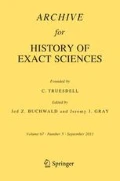Abstract
Most of what is told in this paper has been told before by the same author, in a number of publications of various kinds, but this is the first time that all this material has been brought together and treated in a uniform way. Smaller errors in the earlier publications are corrected here without comment. It has been known since the 1920s that quadratic equations played a prominent role in Babylonian mathematics. See, most recently, Høyrup (Hist Sci 34:1–32, 1996, and Lengths, widths, surfaces: a portrait of old Babylonian algebra and its kin. Springer, New York, 2002). What has not been known, however, is how quadratic equations came to play that role, since it is difficult to think of any practical use for quadratic equations in the life and work of a Babylonian scribe. One goal of the present paper is to show how the need to find solutions to quadratic equations actually arose in Mesopotamia not later than in the second half of the third millennium BC, and probably before that in connection with certain geometric division of property problems. This issue was brought up for the first time in Friberg (Cuneiform Digit Lib J 2009:3, 2009). In this connection, it is argued that the tool used for the first exact solution of a quadratic equation was either a clever use of the “conjugate rule” or a “completion of the square,” but that both methods ultimately depend on a certain division of a square, the same in both cases. Another, closely related goal of the paper is to discuss briefly certain of the most impressive achievements of anonymous Babylonian mathematicians in the first half of the second millennium BC, namely recursive geometric algorithms for the solution of various problems related to division of figures, more specifically trapezoidal fields. For an earlier, comprehensive (but less accessible) treatment of these issues, see Friberg (Amazing traces of a Babylonian origin in Greek mathematics. WorldScientific, Singapore 2007b, Ch. 11 and App. 1).























Similar content being viewed by others
References
Bruins, E.M., and M. Rutten. 1961. Textes Mathématiques de Suse. Paris: Paul Geuthner.
Clay, A.T. 1915. Miscellaneous Inscriptions in the Yale Babylonian Collection (YOS 1). New Haven: Yale University Press.
Deimel, A. 1923. Schultexte aus Fara (WVDOG 43). Leipzig.
Englund, R.K. 1997. Proto-Cuneiform Texts from Diverse Collections (MSVO 4). Berlin: Gebr. Mann.
Englund, R.K., and J.-P. Grégoire. 1991. The Proto-Cuneiform Texts from Jemdet Nasr (MSVO 1). Berlin: Gebr. Mann.
Friberg, J. 1981. Plimpton 322, Pythagorean triples, and the Babylonian triangle parameter equations. Historia Mathematica 8: 277–318.
Friberg, J. 1986. Three remarkable texts from ancient Ebla. Vicino Oriente 6: 3–25.
Friberg, J. 1997. Seed and reeds continued: Another metro-mathematical topic text from Late Babylonian Uruk. Baghdader Mitteilungen 28: 251–365.
Friberg, J. (1997/98) Round and almost round numbers in proto-literate metro-mathematical field texts. Archiv für Orientforschung 44/45: 1–58.
Friberg, J. 1999a. Proto-literate counting and accounting in the Middle East. Examples from two new volumes of proto-cuneiform texts. Journal of Cuneiform Studies 51: 107–137.
Friberg, J. 1999b. A Late Babylonian factorization algorithm for the computation of reciprocals of many-place sexagesimal number. Baghdader Mitteilungen 30: 139–161.
Friberg, J. 2005. Unexpected Links between Egyptian and Babylonian Mathematics. Singapore: WorldScientific.
Friberg, J. 2007a. A Remarkable Collection of Babylonian Mathematical Texts. (Manuscripts in the Schøyen Collection: Cuneiform Texts 1). New York: Springer.
Friberg, J. 2007b. Amazing Traces of a Babylonian Origin in Greek Mathematics. Singapore: WorldScientific.
Friberg, J. 2009. A geometric algorithm with solutions to quadratic equations in a Sumerian Juridical document from Ur III Umma. Cuneiform Digital Library Journal 2009:3.
Friberg, J. 2013. Seven-sided star figures and tuning algorithms in Mesopotamian, Greek, and Islamic texts. Archiv für Orientforschung 52: 121–155.
Friberg, J., H. Hunger, and F.N. Al-Rawi. 1990. Seed and Reeds, a metro-mathematical topic text from Late Babylonian Uruk. Baghdader Mitteilungen 21: 483–557.
Green, M.W., and H.J. Nissen. 1987. Zeichenliste der archaischen Texte aus Uruk (ATU 2). Berlin: Gebr. Mann.
Heath, T.L. 1981. A History of Greek Mathematics, vol. 2. New York: Dover.
Høyrup, J. 1982. Investigations of an Early Sumerian division problem. Historia Mathematica 9: 19–36.
Høyrup, J. 1996. Changing trends in the historiography of Mesopotamian mathematics: An insider’s view. History of Science 34: 1–32.
Høyrup, J. 2002. Lengths, widths, surfaces: A portrait of Old Babylonian algebra and its kin. New York: Springer.
Jestin, R.R. 1937. Tablettes sumériennes de Shuruppak. Paris.
Luckenbill, D.D. 1930. Inscriptions from Adab (OIP 14). Chicago.
Neugebauer, O. 1935. Matematische Keilschrift-Texte 1. Berlin: Springer.
Neugebauer, O., and A. Sachs. 1945. Mathematical Cuneiform Texts. New Haven: American Oriental Society.
Nissen, H.J., P. Damerow, and R.K. Englund. 1993. Archaic Bookkeeping, Early Writing and Techniques of Economic Administration in the Ancient Near East. Chicago, London: The University of Chicago Press.
Proust, C. 2007. Tablettes Mathématiques de Nippur. Paris: De Boccard.
Vaiman, A.A. 1955. Ermitazhnaya klinopisnaya matematicheskaya tablichka No. 015189. Epigrafika Vostoka 10: 71–83.
Vaiman, A.A. 1961. Shumero-Vavilonskaya Mathematika. Moskva: Izdatel’stvo Vostochnoi Literatury.
Author information
Authors and Affiliations
Corresponding author
Additional information
Communicated by : Jeremy Gray.
Rights and permissions
About this article
Cite this article
Friberg, J. Geometric division problems, quadratic equations, and recursive geometric algorithms in Mesopotamian mathematics. Arch. Hist. Exact Sci. 68, 1–34 (2014). https://doi.org/10.1007/s00407-013-0122-4
Received:
Published:
Issue Date:
DOI: https://doi.org/10.1007/s00407-013-0122-4




